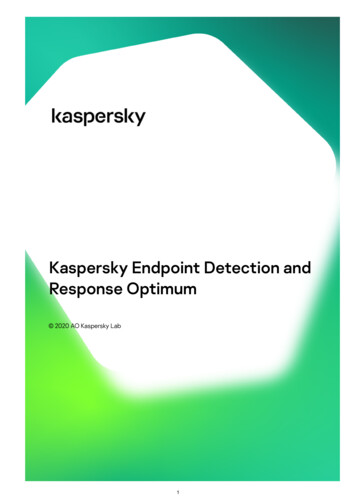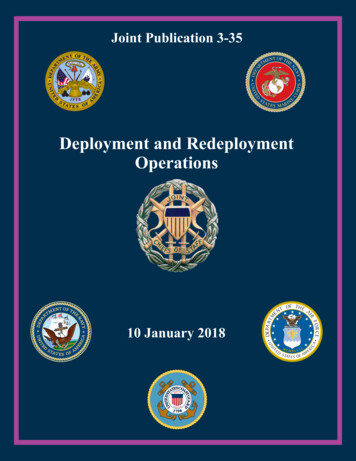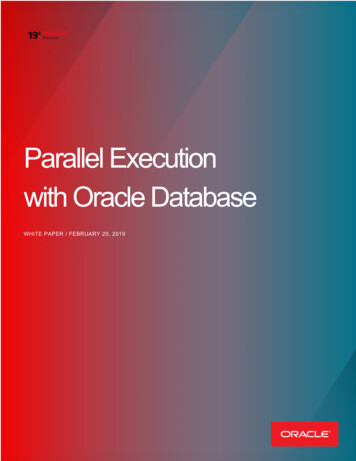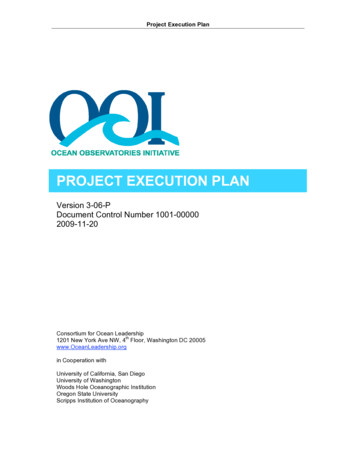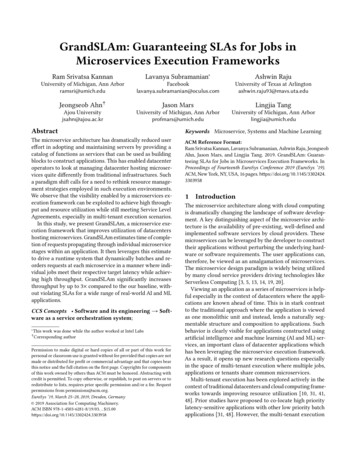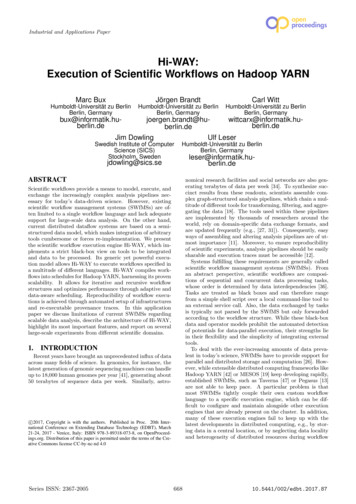
Transcription
Industrial and Applications PaperHi-WAY:Execution of Scientific Workflows on Hadoop YARNMarc BuxJörgen BrandtCarl WittHumboldt-Universität zu BerlinBerlin, GermanyHumboldt-Universität zu BerlinBerlin, GermanyHumboldt-Universität zu BerlinBerlin, wittcarx@informatik.huberlin.deberlin.deJim DowlingUlf LeserSwedish Institute of ComputerScience (SICS)Stockholm, SwedenHumboldt-Universität zu BerlinBerlin, Germanyjdowling@sics.seABSTRACTnomical research facilities and social networks are also generating terabytes of data per week [34]. To synthesize succinct results from these readouts, scientists assemble complex graph-structured analysis pipelines, which chain a multitude of different tools for transforming, filtering, and aggregating the data [18]. The tools used within these pipelinesare implemented by thousands of researchers around theworld, rely on domain-specific data exchange formats, andare updated frequently (e.g., [27, 31]). Consequently, easyways of assembling and altering analysis pipelines are of utmost importance [11]. Moreover, to ensure reproducibilityof scientific experiments, analysis pipelines should be easilysharable and execution traces must be accessible [12].Systems fulfilling these requirements are generally calledscientific workflow management systems (SWfMSs). Froman abstract perspective, scientific workflows are compositions of sequential and concurrent data processing tasks,whose order is determined by data interdependencies [36].Tasks are treated as black boxes and can therefore rangefrom a simple shell script over a local command-line tool toan external service call. Also, the data exchanged by tasksis typically not parsed by the SWfMS but only forwardedaccording to the workflow structure. While these black-boxdata and operator models prohibit the automated detectionof potentials for data-parallel execution, their strengths liein their flexibility and the simplicity of integrating externaltools.To deal with the ever-increasing amounts of data prevalent in today’s science, SWfMSs have to provide support forparallel and distributed storage and computation [26]. However, while extensible distributed computing frameworks likeHadoop YARN [42] or MESOS [19] keep developing rapidly,established SWfMSs, such as Taverna [47] or Pegasus [13]are not able to keep pace. A particular problem is thatmost SWfMSs tightly couple their own custom workflowlanguage to a specific execution engine, which can be difficult to configure and maintain alongside other executionengines that are already present on the cluster. In addition,many of these execution engines fail to keep up with thelatest developments in distributed computing, e.g., by storing data in a central location, or by neglecting data localityand heterogeneity of distributed resources during workflowScientific workflows provide a means to model, execute, andexchange the increasingly complex analysis pipelines necessary for today’s data-driven science. However, existingscientific workflow management systems (SWfMSs) are often limited to a single workflow language and lack adequatesupport for large-scale data analysis. On the other hand,current distributed dataflow systems are based on a semistructured data model, which makes integration of arbitrarytools cumbersome or forces re-implementation. We presentthe scientific workflow execution engine Hi-WAY, which implements a strict black-box view on tools to be integratedand data to be processed. Its generic yet powerful execution model allows Hi-WAY to execute workflows specified ina multitude of different languages. Hi-WAY compiles workflows into schedules for Hadoop YARN, harnessing its provenscalability. It allows for iterative and recursive workflowstructures and optimizes performance through adaptive anddata-aware scheduling. Reproducibility of workflow executions is achieved through automated setup of infrastructuresand re-executable provenance traces. In this applicationpaper we discuss limitations of current SWfMSs regardingscalable data analysis, describe the architecture of Hi-WAY,highlight its most important features, and report on severallarge-scale experiments from different scientific domains.1.INTRODUCTIONRecent years have brought an unprecedented influx of dataacross many fields of science. In genomics, for instance, thelatest generation of genomic sequencing machines can handleup to 18,000 human genomes per year [41], generating about50 terabytes of sequence data per week. Similarly, astro-c 2017, Copyright is with the authors. Published in Proc. 20th International Conference on Extending Database Technology (EDBT), March21-24, 2017 - Venice, Italy: ISBN 978-3-89318-073-8, on OpenProceedings.org. Distribution of this paper is permitted under the terms of the Creative Commons license CC-by-nc-nd 4.0Series ISSN: 2/edbt.2017.87
scheduling [10]. Furthermore, despite reproducibility beingadvocated as a major strength of scientific workflows, mostsystems focus only on sharing workflows, disregarding theprovisioning of input data and setup of the execution environment [15, 33]. Finally, many systems severely limit theexpressiveness of their workflow language, e.g., by disallowing conditional or recursive structures. While the scientificworkflow community is becoming increasingly aware of theseissues (e.g., [8, 33, 50]), to date only isolated, often domainspecific solutions addressing only subsets of these problemshave been proposed (e.g., [6, 14, 38]).At the same time, support for many of these features hasbeen implemented in several recently developed distributeddataflow systems, such as Spark [49] or Flink [5]. However,such systems employ a semi-structured white-box (e.g., keyvalue-based) data model to automatically partition and parallelize dataflows. Unfortunately, a structured data modelimpedes the flexibility in workflow design when integratingexternal tools that read and write file-based data. To circumvent this problem, additional glue code for transformingto and from the structured data model has to be provided.This introduces unnecessary overhead in terms of time required for implementing the glue code as well as for thenecessary data transformations at runtime [48].In this application paper, we present the Hi-WAY Workflow Application master for YARN. Technically, Hi-WAYis yet another application master for YARN. Conceptually,it is a (surprisingly thin) layer between scientific workflowspecifications expressed in different languages and HadoopYARN. It emphasizes data center compatibility by beingable to run on YARN installations of any size and type ofunderlying infrastructure. Compared to other SWfMSs, HiWAY brings the following specific features.5. Scalable execution. By employing Hadoop YARN asits underlying execution engine, Hi-WAY harnesses itsscalable resource management, fault tolerance, and distributed file management (see Section 3.1).While some of these features have been briefly outlinedin the context of a demonstration paper [9], this is the firstcomprehensive description of Hi-WAY.The remainder of this paper is structured as follows: Section 2 gives an overview of related work. Section 3 presentsthe architecture of Hi-WAY and gives detailed descriptionsof the aforementioned core features, which are highlightedin italic font throughout the rest of the document. Section 4describes several experiments showcasing these feature inreal-life workflows on both local clusters and cloud computing infrastructure. Section 5 concludes the paper.2. RELATED WORKProjects with goals similar to Hi-WAY can be separatedinto two groups. The first group of systems comprises traditional SWfMSs, which, like Hi-WAY, employ black-box dataand operator models. The second group encompasses distributed dataflow systems developed to process mostly structured or semi-structured (white-box) data. For a comprehensive overview of data-intensive scientific workflow management, readers are referred to [10] and [26].2.1Scientific Workflow ManagementThe SWfMS Pegasus [13] emphasizes scalability, utilizingHTCondor as its underlying execution engine. It enforcesthe usage of its own XML-based workflow language calledDAX. Pegasus supports a number of scheduling policies, allof which are static, yet some of which can be consideredadaptive (such as HEFT [39]). Finally, Pegasus does notallow for iterative workflow structures, since every task invocation has to be explicitly described in the DAX file. Incontrast to Hi-WAY, Pegasus does not provide any meansof reproducing scientific experiments across datacenters. HiWAY complements Pegasus by enabling Pegasus workflowsto be run on top of Hadoop YARN, as outlined in Section 3.2.Taverna [47] is an established SWfMS that focuses on usability, providing a graphical user interface for workflow design and monitoring as well as a comprehensive collection ofpre-defined tools and remote services. Taverna emphasizesreproducibility of experiments and workflow sharing by integrating the public myExperiment workflow repository [16],in which over a thousand Taverna workflows have been madeavailable. However, Taverna is mostly used to integrate webservices and short-running tasks and thus does not supportscalable distribution of workload across several worker nodesor any adaptive scheduling policies.Galaxy [17] is a SWfMS that provides a web-based graphical user interface, an array of built-in libraries with a focus on computational biology, and a repository for sharingworkflows and data. CloudMan [3] extends Galaxy withlimited scalability by enabling Galaxy clusters of up to 20nodes to be set up on Amazon’s EC2 through an easy-to-useweb interface. Unfortunately, Galaxy neither supports adaptive scheduling nor iterative workflow structures. Similar toPegasus and as described in Section 3.2, Hi-WAY complements Galaxy by allowing exported Galaxy workflows to berun on Hadoop YARN. For a comparative evaluation of HiWAY and Galaxy CloudMan, refer to Section 4.2.1. Multi-language support. Hi-WAY employs a genericyet powerful execution model. It has no own specification language, but instead comes with an extensiblelanguage interface and built-in support for multipleworkflow languages, such as Cuneiform [8], PegasusDAX [13], and Galaxy [17] (see Section 3.2).2. Iterative workflows. Hi-WAY’s execution model is expressive enough to support data-dependent controlflow decisions. This allows for the design of conditional, iterative, and recursive structures, which are increasingly common in distributed dataflows (e.g., [28]),yet are just beginning to emerge in scientific workflows(see Section 3.3).3. Performance gains through adaptive scheduling. HiWAY supports various workflow scheduling algorithms.It utilizes statistics of earlier workflow executions to estimate the resource requirements of tasks awaiting execution and exploit heterogeneity in the computationalinfrastructures during scheduling. Also, Hi-WAY supports adaption of schedules to both data locality andresource availability (see Section 3.4).4. Reproducible experiments. Hi-WAY generates comprehensive provenance traces, which can be directly reexecuted as workflows (see Section 3.5). Also, Hi-WAYuses Chef [2] and Karamel [1] for specifying automatedsetups of a workflow’s software requirements and input data, including (if necessary) the installation ofHi-WAY and Hadoop (see Section 3.6).669
Text-based parallel scripting languages like Makeflow [4],Snakemake [23], or Swift [45] are more light-weight alternatives to full-fledged SWfMSs. Swift [45] provides a functional scripting language that facilitates the design of inherently data-parallel workflows. Conversely, Snakemake [23]and Makeflow [4] are inspired by the build automation toolGNU make, enabling a goal-driven assembly of workflowscripts. All of these system have in common that theysupport the scalable execution of implemented workflowson distributed infrastructures, yet disregard other featurestypically present in SWfMSs, such as adaptive schedulingmechanisms or support for reproducibility.Nextflow [38] is a recently proposed SWfMS [14], whichbrings its own domain-specific language. In Nextflow, software dependencies can be provided in the form of Dockeror Shifter containers, which facilitates the design of reproducible workflows. Nextflow enables scalable execution bysupporting several general-purpose batch schedulers. Compared to Hi-WAY, execution traces are less detailed and notre-executable. Furthermore, Nextflow does not exploit dataaware and adaptive scheduling potentials.Toil [43] is a multi-language SWfMS that supports scalableworkflow execution by interfacing with several distributedresource management systems. Its supported languages include the Common Workflow Language (CWL) [6], a YAMLbased workflow language that unifies concepts of variousother languages, and a custom Python-based DSL that supports the design of iterative workflows. Similar to Nextflow,Toil enables sharable and reproducible workflow runs by allowing tasks to be wrapped in re-usable Docker containers.In contrast to Hi-WAY, Toil does not gather comprehensiveprovenance and statistics data and, consequently, does notsupport any means of adaptive workflow scheduling.2.2While Tez runs DAGs comprising mostly map and reduce tasks, Hadoop workflow schedulers like Oozie [20] orAzkaban [35] have been developed to schedule DAGs consisting mostly of Hadoop jobs (e.g., MapReduce, Pig, Hive)on a Hadoop installation. In Oozie, tasks composing a workflow are transformed into a number of MapReduce jobs atruntime. When used to run arbitrary scientific workflows,systems like Oozie or Azkaban either introduce unnecessary overhead by wrapping the command-line tasks into degenerate MapReduce jobs or do not dispatch such tasks toHadoop, but run them locally instead.Chiron [30] is a scalable workflow management system inwhich data is represented as relations and workflow tasksimplement one out of six higher-order functions (e.g., map,reduce, and filter). This departure from the black-box viewon data inherent to most SWfMSs enables Chiron to applyconcepts of database query optimization to optimize performance through structural workflow reordering [29]. Incontrast to Hi-WAY, Chiron is limited to a single, custom,XML-based workflow language, which does not support iterative workflow structures. Furthermore, while Chiron, likeHi-WAY, is one of few systems in which a workflow’s (incomplete) provenance data can be queried during executionof that same workflow, Chiron does not employ this data toperform any adaptive scheduling.3. ARCHITECTUREHi-WAY utilizes Hadoop as its underlying system for themanagement of both distributed computational resourcesand storage (see Section 3.1). It comprises three main components, as shown in Figure 1. First, the Workflow Driverparses a scientific workflow specified in any of the supportedworkflow languages and reports any discovered tasks to theWorkflow Scheduler (see Sections 3.2 and 3.3). Secondly, theWorkflow Scheduler assigns tasks to compute resources provided by Hadoop YARN according to a selected schedulingpolicy (see Section 3.4). Finally, the Provenance Managergathers comprehensive provenance and statistics information obtained during task and workflow execution, handlingtheir long-term storage and providing the Workflow Scheduler with up-to-date statistics on previous task executions(see Section 3.5). Automated installation routines for thesetup of Hadoop, Hi-WAY, and selected workflows are described in Section 3.6.Distributed Dataflows SystemsDistributed dataflow systems like Spark [49] or Flink [5]have recently achieved strong momentum both in academiaand in industry. These systems operate on semi-structureddata and support different programming models, such asSQL-like expression languages or real-time stream processing. Departing from the black-box data model along withnatively supporting concepts like data streaming and inmemory computing allows these systems to in many casesexecute even sequential processing steps in parallel and circumvent the materialization of intermediate data on thehard disk. It also enables the automatic detection and exploitation of potentials for data parallelism. However, theresulting gains in performance come at the cost of reducedflexibility for workflow designers. This is especially problematic for scientists from domains other than the computational sciences. Since integrating external tools processing unstructured, file-based data is often tedious and undermines the benefits provided by dataflow systems, a substantial amount of researchers continue to rely on traditionalscripting and programming languages to tackle their dataintensive analysis tasks (e.g., [27, 31]).Tez [32] is an application master for YARN that enablesthe execution of DAGs comprising map, reduce, and customtasks. Being a low-level library intended to be interfacedby higher-level applications, external tools consuming andproducing file-based data need to be wrapped in order to beused in Tez. For a comparative evaluation between Hi-WAYand Tez, see Section 4.1.3.1Interface with Hadoop YARNHadoop version 2.0 introduced the resource managementcomponent YARN along with the concept of job-specific application masters (AMs), increasing scalability beyond 4,000computational nodes and enabling native support for nonMapReduce AMs. Hi-WAY seizes this concept by providingits own AM that interfaces with YARN.To submit workflows for execution, Hi-WAY provides alight-weight client program. Each workflow that is launchedfrom a client results in a separate instance of a Hi-WAY AMbeing spawned in its own container. Containers are YARN’sbasic unit of computation, encapsulating a fixed amount ofvirtual processor cores and memory which can be specifiedin Hi-WAY’s configuration. Having one dedicated AM perworkflow results in a distribution of the workload associatedwith workflow execution management and is therefore required to fully unlock the scalability potential provided byHadoop.670
Figure 1: The architecture of the Hi-WAY application master: The Workflow Driver, described in Sections 3.2 and 3.3, parses a textual workflow file, monitors workflow execution, and notifies the WorkflowScheduler whenever it discovers new tasks. For tasksthat are ready to be executed, the Workflow Scheduler, presented in Section 3.4, assembles a schedule. Provenance and statistics data obtained duringworkflow execution are handled by the ProvenanceManager (see Section 3.5) and can be stored in a local file as well as a MySQL or Couchbase database.Figure 2: Functional interaction between the components of Hi-WAY and Hadoop (white boxes; seeSection 3.1) as well as further requirements for running workflows (gray boxes; see Section 3.6). Aworkflow is launched from a client application, resulting in a new instance of a Hi-WAY AM withina container provided by one of YARN’s NodeManagers (NMs). This AM parses the workflow file residing in HDFS and prompts YARN to spawn additional worker containers for tasks that are ready torun. During task execution, these worker containersobtain input data from HDFS, invoke locally available executables, and generate output data, which isplaced in HDFS for use by other worker containers.For any of a workflow’s tasks that await execution, the HiWAY AM responsible for running this particular workflowthen requests an additional worker container from YARN.Once allocated, the lifecycle of these worker containers involves (i) obtaining the task’s input data from HDFS, (ii) invoking the commands associated with the task, and (iii) storing any generated output data in HDFS for consumption byother containers executing tasks in the future and possiblyrunning on other compute nodes. Figure 2 illustrates thisinteraction between Hi-WAY’s client application, AM andworker containers, as well as Hadoop’s HDFS and YARNcomponents.Besides having dedicated AM instances per workflow, another prerequisite for scalable workflow execution is the ability to recover from failures. To this end, Hi-WAY is able tore-try failed tasks, requesting YARN to allocate the additional containers on different compute nodes. Also, dataprocessed and produced by Hi-WAY persists through thecrash of a storage node, since Hi-WAY exploits the redundant file storage of HDFS for any input, output, and intermediate data associated with a workflow.3.2libraries independent of their programming API. Cuneiformfacilitates the assembly of highly parallel data processingpipelines by providing a range of second-order functions extending beyond map and reduce operations.DAX [13] is Pegasus’ built-in workflow description language, in which workflows are specified in an XML file.Contrary to Cuneiform, DAX workflows are static, explicitly specifying every task to be invoked and every file to beprocessed or produced by these tasks during workflow execution. Consequently, DAX workflows can become quite largeand are not intended to be read or written by workflow developers directly. Instead, APIs enabling the generation ofDAX workflows are provided for Java, Python, and Perl.Workflows in the web-based SWfMS Galaxy [17] can becreated using a graphical user interface, in which the taskscomprising the workflow can be selected from a large rangeof software libraries that are part of any Galaxy installation. This process of workflow assembly results in a staticworkflow graph that can be exported to a JSON file, whichcan then be interpreted by Hi-WAY. In workflows exportedfrom Galaxy, the workflow’s input files are not explicitlydesignated. Instead, input ports serve as placeholders forthe input files, which are resolved interactively when theworkflow is committed to Hi-WAY for execution.In addition to these workflow languages, Hi-WAY can easily be extended to parse and execute other non-interactiveworkflow languages. For non-iterative languages, one onlyneeds to extend the Workflow Driver class and implementthe method that parses a textual workflow file to determinethe tasks and data dependencies composing the workflow.Workflow Language InterfaceHi-WAY sunders the tight coupling of scientific workflowlanguages and execution engines prevalent in establishedSWfMSs. For this purpose, its Workflow Driver (see Section 3.3) provides an extensible, multilingual language interface, which is able to interpret scientific workflows writtenin a number of established workflow languages. Currently,four scientific workflow languages are supported: (i) the textual workflow language Cuneiform [8], (ii) DAX, which is theXML-based workflow language of the SWfMS Pegasus [13],(iii) workflows exported from the SWfMS Galaxy [17], and(iv) Hi-WAY provenance traces, which can also be interpreted as scientific workflows (see Section 3.5).Cuneiform [8] is a minimal workflow language that supports direct integration of code written in a large range of external programming languages (e.g., Bash, Python, R, Perl,Java). It supports iterative workflows and treats tasks asblack boxes, allowing the integration of various tools and3.3Iterative Workflow DriverOn execution onset, the Workflow Driver parses the workflow file to determine inferable tasks along with the files they671
process and produce. Any discovered tasks are passed to theWorkflow Scheduler, which then assembles a schedule andcreates container requests whenever a task’s data dependencies are met. Subsequently, the Workflow Driver supervisesworkflow execution, waiting for container requests to be fulfilled or for tasks to terminate. In the former case, the Workflow Driver requests the Workflow Scheduler to choose a taskto be launched in that container. In the latter case, theWorkflow Driver registers any newly produced data, whichmay induce new tasks becoming ready for execution andthus new container requests to be issued.One of Hi-WAY’s core strengths is its ability to interpretiterative workflows, which may contain unbounded loops,conditionals, and recursive tasks. In such iterative workflows, the termination of a task may entail the discovery ofentirely new tasks. For this reason, the Workflow Driverdynamically evaluates the results of completed tasks, forwarding newly discovered tasks to the Workflow Scheduler,similar to during workflow parsing. See Figure 3 for a visualization of the Workflow Driver’s execution model.that optimize performance for different workflow structuresand computational architectures.Most established SWfMSs employ a first-come-first-served(FCFS) scheduling policy in which tasks are placed at thetail of a queue, from whose head they are removed and dispatched for execution whenever new resources become available. While Hi-WAY supports FCFS scheduling as well, itsdefault scheduling policy is a data-aware scheduler intendedfor I/O-intensive workflows. The data-aware scheduler minimizes data transfer by assigning tasks to compute nodesbased on the amount of input data that is already presentlocally. To this end, whenever a new container is allocated,the data-aware scheduler skims through all tasks pendingexecution, from which it selects the task with the highestfraction of input data available locally (in HDFS) on thecompute node hosting the newly allocated container.In contrast to data-aware and FCFS scheduling, staticscheduling policies employ a pre-built schedule, which dictates how the tasks composing a workflow are to be assignedto available compute nodes. When configured to employ astatic scheduling policy, Hi-WAY’s Workflow Scheduler assembles this schedule at the beginning of workflow executionand enforces containers to be placed on specific computenodes according to this schedule. A basic static scheduling policy supported by Hi-WAY is a round-robin schedulerthat assigns tasks in turn, and thus in equal numbers, to theavailable compute nodes.In addition to these scheduling policies, Hi-WAY is alsoable to employ adaptive scheduling in which the assignmentof tasks to compute nodes is based on continually updatedruntime estimates and is therefore adapted to the computational infrastructure. To determine such runtime estimates,the Provenance Manager, which is responsible for gathering, storing, and providing provenance and statistics data(see Section 3.5), supplies the Workflow Scheduler with exhaustive statistics. For instance, when deciding whether toassign a task to a newly allocated container on a certaincompute node, the Workflow Scheduler can query the Provenance Manager for (i) the observed runtimes of earlier tasksof the same signature (i.e., invoking the same tools) runningon either the same or other compute nodes, (ii) the namesand sizes of the files being processed in these tasks, and(iii) the data transfer times for obtaining this input data.If available, based on this information the Workflow Scheduler is able to determine runtime estimates for running anytask on any machine. In order to quickly adapt to performance changes in the computational infrastructure, thecurrent strategy for computing these runtime estimates is toalways use the latest observed runtime. If no runtimes havebeen observed yet for a particular task-machine-assignment,a default runtime of zero is assumed to encourage trying outnew assignments and thus obtain a more complete pictureof which task performs well on which machine.To make use of these runtime estimates, Hi-WAY supportsheterogeneous earliest finish time (HEFT) [39] scheduling.HEFT exploits heterogeneity in both the tasks to be executed as well as the underlying computational infrastructure. To this end, it uses runtime estimates to rank tasksby the expected time required from task onset to workflowterminus. By decreasing rank, tasks are assigned to compute nodes with a favorable runtime estimate, i.e., criticaltasks with a longer time to finish are placed on the bestperforming nodes first.Figure 3: The iterative Workflow Driver’s executionmodel. A workflow is parsed, entailing the discovery of tasks as well as the request for and eventualallocation of containers for ready tasks. Upon termination of a task executed in an allocated container,previously discovered tasks might become ready (resulting in new container requests), new tasks mightbe discovered, or the workflow might terminate.As an example for an iterative workflow, consider an implementation of the k -means clustering algorithm commonlyencountered in machine learning applications. k -means provides a heuristic for partitioning a number of data pointsinto k clusters. To this end, over a sequence of parallelizable steps, an initial random clustering is iteratively refineduntil convergence is reached. Only by means of conditionaltask execution and unbounded iteration can this algorithmbe implemented as a workflow, which underlines the importance of such iterative control structures in scientific workflows. The implementation of the k -means algorithm as aCuneiform workflow has been published in [9].3.4Workflow SchedulerDetermining a suitable assignment of tasks to computenodes is called workflow scheduling. To this end, the Workflow Scheduler receives tasks discovered by the WorkflowDriver, from which it builds a schedule and creates containerrequests. Based on this schedule, the Workflow Schedulerselects a task for execution whenever a container has beenallocated. This higher-level scheduler is different to YARN’sinternal schedulers, which, at a lower level, determine how todistribute resources between multiple users and applications.Hi-WAY provides a selection of workflow scheduling policies672
Since static schedulers like round-robin and HEFT requirethe complete invocation graph of a workflow to be deductibleat the onset of computation, static scheduling can not beused in conjunction with workflow languages that allow iterative workflows. Hence, the latter two (static) schedulingpo
Hi-WAY and Hadoop (see Section 3.6). 5. Scalable execution. By employing Hadoop YARN as its underlying execution engine, Hi-WAY harnesses its scalable resource management, fault tolerance, and dis-tributed le management (see Section 3.1). While some of these features have been brie y outlined in the context of a demonstration paper [9], this is .
